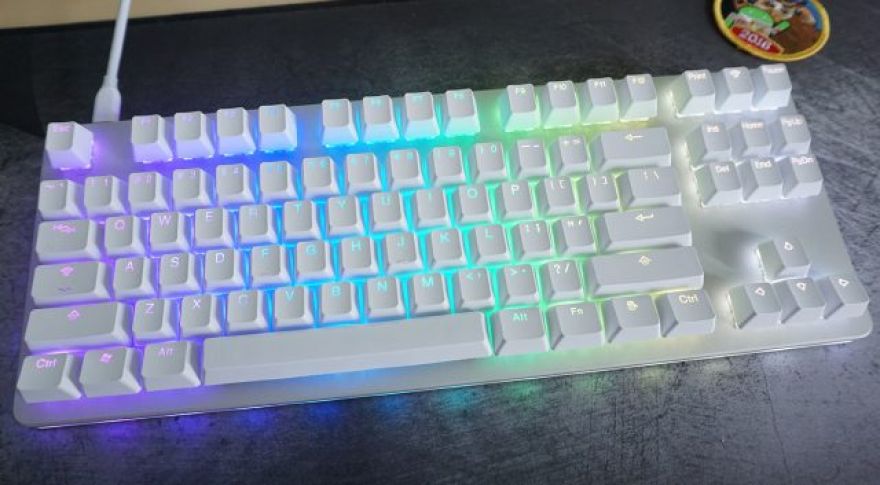
Hands On With the ‘K-Type,’ an Infinitely Customizable Mechanical Keyboard
Mechanical keyboards have gotten incredibly popular in the last few years. You can now go buy a mech on Amazon for a reasonable amount of money. The surge of interest in mechs also supports a small but thriving custom keyboard community. I make no secret of my obsession with custom mechanical keyboards, which offer a number of great features over the “mainstream” mechs you can buy on Amazon. They’re more configurable, come in different form factors, and offer a wider variety of switches.
It can take a lot of legwork to get your hands on the perfect board — you might have to build it yourself and fumble with buggy firmware tools to program it.
Design
The K-Type is a tenkeyless board, meaning it has all the standard keys of a full-sized board except the number pad. In my experience, many people who think the need a number pad actually do not. Smaller keyboards make a lot of sense because you can have your mouse closer, and you don’t have to reach as far across the keyboard to hit all the keys. Because the layout is completely standard, you’ll have no trouble finding replacement keycap sets for this board. On a slightly technical note, it uses Cherry-style stabilizers under the longer keys. I prefer these as they tend to be quieter and make swapping keycaps easier.
The K-type is obviously not the only tenkeyless board in existence, but it has a lot of other tricks. This board has a solid aluminum frame with an interesting design. The top and side is machined out of a single piece of aluminum, and then the bottom panel screws on. That means the circuit board goes in from the bottom, and the switches plug into the case. This gives it an incredibly solid feel because there’s not a separate switch plate. The case is the plate.
All the screws are hidden on the bottom of the case, giving it a clean look. The board also has a cool magnetic foot that clips on. Some might feel the incline is too steep, but I think it’s just right (Input Club says it’s the same angle as the WhiteFox).
Like a lot of keyboards these days, the K-Type has RGB LEDs, but it goes a step further than other boards I’ve seen. The PCB for this board has SMD LEDs under each switch, plus more LEDs on the bottom for the edge lighting. These are brighter than regular LEDs that plug into the switch tops, and they allow for the K-Type’s unique switch features (which I’ll get into later).
On the top of the K-Type is something else you don’t often see on keyboards — a USB Type-C port. Actually, there are two of them at opposite ends of the board. You can plug into whichever one is more convenient for you. The other port can be used to charge something that works with Type-C (like a phone), but the more interesting option is daisy-chaining other Input Club devices together. This only works with devices that run the KLL firmware, including the and Ergodox Infinity. Not terribly useful right now, but it could be cool in the future.
Switches
The K-Type will come with several different switch options (including clicky and tactile varieties) from a company called Kailh. I don’t usually consider Kailh a top-tier switch maker, but these are new and improved designs. If you don’t like the included switches, you don’t have to use them. One of the coolest things about this board is that it has hot-swappable switches. There are a couple that have swappable switches, but this is the best implementation of the feature I’ve seen. According to Input Club, the swapping mechanism is durable, rated for up to thousands of swaps.
You don’t even have to turn the keyboard off — just take the keycaps off and use the included tool to detach the switch from the board. Plug in a different switch, and you’re all set. The switches stay put and don’t wobble at all. The K-type can accept any Cherry-style switch, as long as it’s “plate-mount.” That means it doesn’t have the mounting pegs on the underside of the housing. You can get switches like this no problem, or just clip the pegs off.
I’ve tested the K-Type with myriad switch types, including Cherry Greens, Gateron Browns, Zealios, and even some weird stuff like the Fosen Aquamarine (see below for a gallery). They all work perfectly, but the SMD LEDs will only shine through with switches that have transparent housings, for example Zealios and some Gateron variants. The switches that come with the K-Type aren’t transparent on the bottom, but they have custom housings that allow the lights to shine through, which also opens up a whole new level of customization.
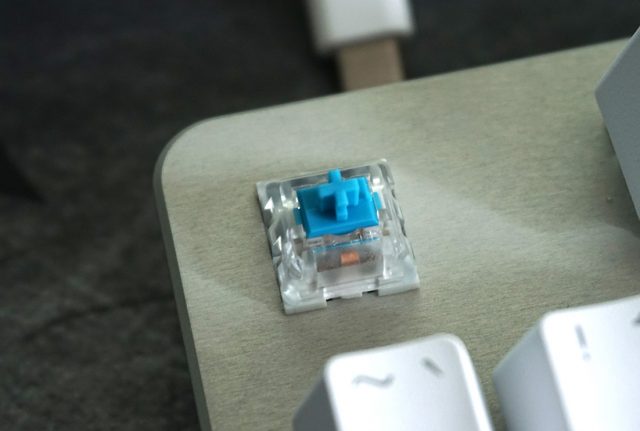
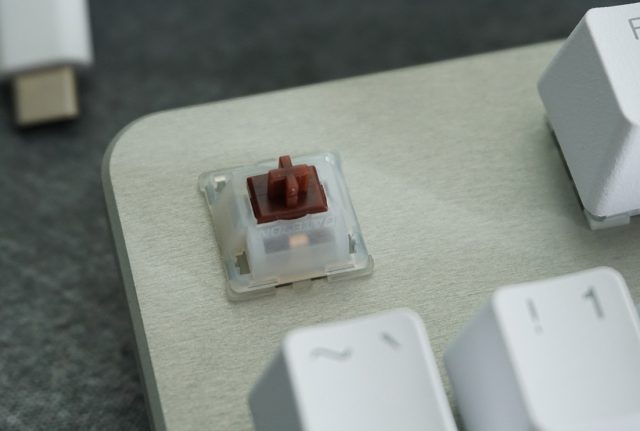

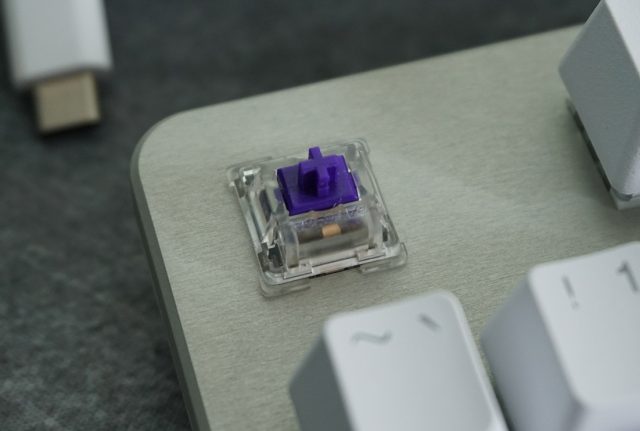
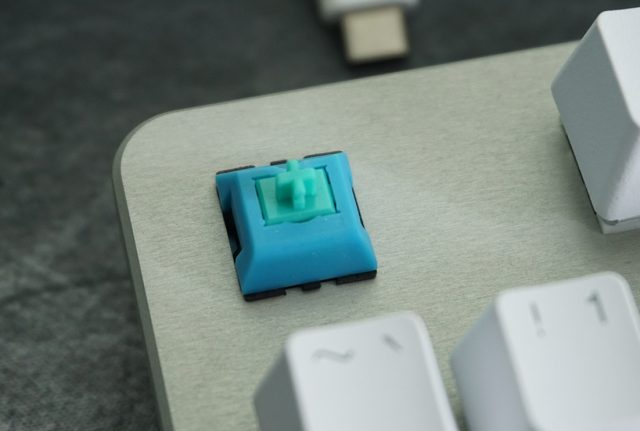
Input Club explains the switch choice was deliberate because it allowed them to get these custom housings into everyone’s hands. There’s a light channel in the space other switches have LED pin holes, and this is what diffuses the light so evenly under the switch. There will also be some “standard” switches as an option when the drop begins, but I think the custom ones are what you want.
The version I have came with the custom Kailh Blue switches. These are clicky, as opposed to tactile or linear. They’re a little heavier than Cherry Blues and have a deeper sounding click. I like them more than I expected — I’m writing all of this on the K-Type, of course.
Left: Included custom Kailh switch, Right: A Zealio switch
If you don’t care for the stock switches, you can still make use of those neat housings. Cherry-style switches became popular because of how simple and robust they are. You can quite easily open the included switches and change out the stem (colored part) and spring. That’s what gives a switch its character, so you can turn the clicky Kailh Blues into a linear or tactile switch. That way, you still get the LED diffuser with whatever feel you want. See above for a comparison between the K-type switch and a Zealio—note the light diffuser on the K-Type housing.
Keycaps
I make no secret of my status as a keycap snob. I’ve spent an embarrassing amount of money on keycaps that often end up costing more than the boards on which I’m using them. The stock keycaps on most boards aren’t impressive. However, the keycaps on the K-Type have been specifically designed for this keyboard, so they’re actually worth using.
Keycaps are usually composed of either ABS or PBT plastic. ABS is softer and smoother, so it’ll wear down over time. The upshot is ABS is ideal for doubleshot molding with any colors you want. PBT is harder and has a “gritty” texture that makes them grippy. However, it’s hard to do doubleshot molding. Consequently, most PBT caps are made with dye sublimation printing. The dye is embedded in the plastic, so they won’t wear off, but this doesn’t work with as many color combinations.
The K-Type’s PBT caps are not the thickest, but they are doubleshot.
The K-Type uses PBT caps in OEM profile that are doubleshot — a rare combination. The legends are transparent, so you can see the pretty lights under them. The legend font is also not obnoxious, as it is on so many “shine-through” caps. I should also give Input Club credit for properly positioning the legends on the cap to be fully illuminated by the LED diffuser, which is toward the top of the switch.
These are nice keycaps, and perfectly suited to the K-Type. And remember, this layout is completely standard, so finding other keycaps you like won’t be a hassle.
Firmware
One of the things that sets the K-Type and other custom boards apart from “mainstream” mechanical keyboards is the firmware. They don’t rely upon a bloated desktop app to control the lights, layouts, or features. After you program and flash a board, it works the same way no matter what you plug it into. This is true of the K-Type, but it goes a step further with a powerful visual configurator app.
Layout configuration.
Part of this system similar to the WhiteFox. However, that board does not have RGB LEDs to manage. Thus, there’s a whole separate system for editing the lighting pattern and animations. The animations are incredibly smooth, too. For the actual keys, you can make the buttons do anything you want. Don’t use caps lock? Change it to function. Want quick access to media controls? Create a new layer for it. You can even change the entire keyboard layout to something like Colemak or Dvorak, if that’s what you’re into.
Changing LED settings.
Flashing the K-Type is similar to the WhiteFox. After building the firmware with the configurator, you simply point it at the keyboard to flash. If you want to get deeper into tweaking keyboard firmware, this could be the ideal device. Input Club will open source the entire board after the first round sale is complete. The firmware will be available online, as will design files for the PCB and even the case.
How can you buy it?
The K-Type does not technically exist in its final form yet. I have a prototype that will be used as a template to put the retail version into production. Massdrop will begin taking orders for the K-type later this month. The price will be $199.99, which is totally reasonable for a high-end keyboard with no assembly required. After the sale concludes in a few weeks, production will start.
Input Club expects a quicker fulfillment than some past keyboard group buys, someplace on the order of three months. So, the K-Type should ship late this summer. I would be remiss if I didn’t point out that group buys do come with some risk. You’re putting your money up to buy a product, and it’ll take however long it takes to get to you. If you need a new keyboard next week, this isn’t for you. For almost anyone else who’s interested in mechanical keyboards, the K-Type should be fantastic.
The build quality is great, the firmware is powerful, and the swappable switch mechanism is the best I’ve seen. Overall, $200 for this keyboard is a bargain. You could spend almost that much on a “gamer” mech on Amazon.